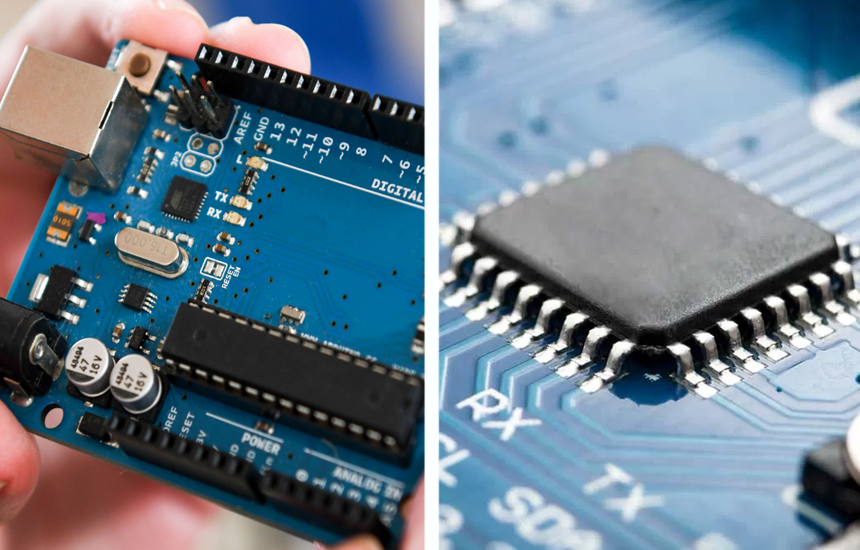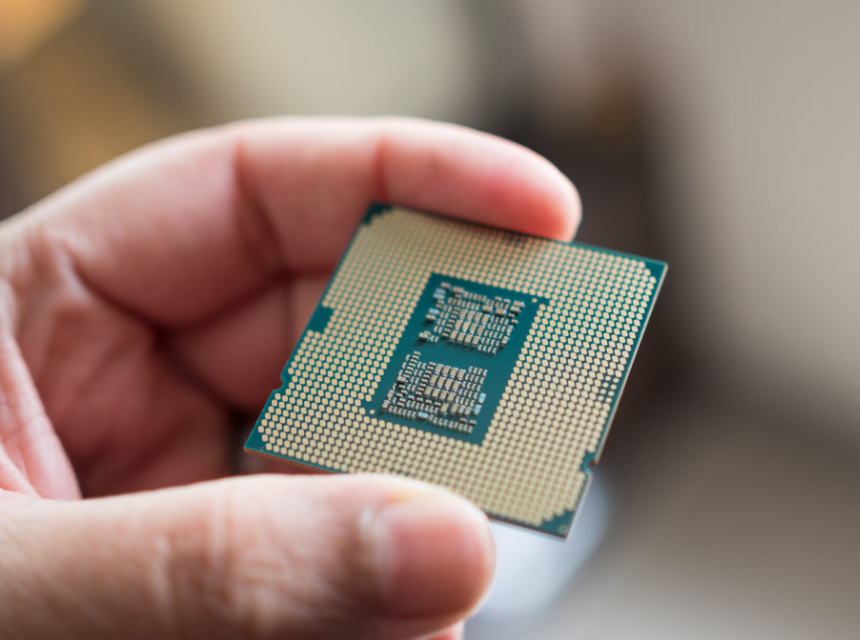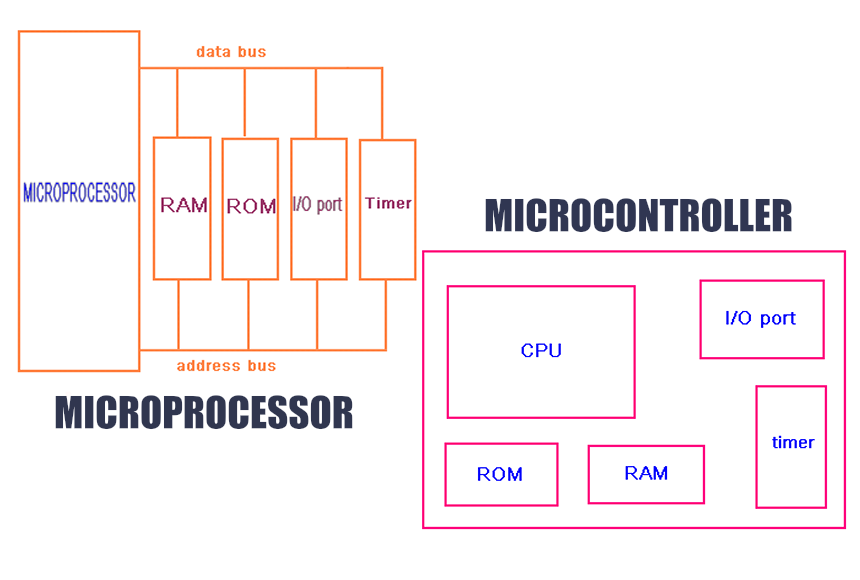- March 8, 2023
- Posted by: Anna Rosenkranz
- Category: Blog

Microcontroller vs. Microprocessor: Spot the Difference
We all use electronic devices throughout our day, including computers, smartphones, calculators, and washing machines. Regardless of how essential these devices are to our day-to-day lives, we don’t always consider what goes on behind the covers and screens.
Two of the most significant parts of these electronics are the microcontrollers and microprocessors. These two parts have similar functions, though they are more different than we may realize, with varying architecture that alters how each one does its job. If you’ve never compared microcontroller vs microprocessor pieces, you may be interested in what each one has to offer in terms of components and use. Let’s take a look at the benefits and limitations of these little devices to see how they function.
What is Microprocessor?

A microprocessor, also called a Central Processing Unit or CPU, is a small device or chip designed to perform all the decision-making tasks in certain electronics. For instance, the motherboard of a desktop computer will have one installed to perform general, logical, numerical, or multimedia tasks, as well as several others. As well as performing the operations of that specific device, this single integrated circuit communicates with any other device connected to it.
Types
There are several different types of microprocessors. These include a Complex Instruction Set Computer Microprocessor (CISC), the Application Specific Integration Circuit (ASIC), a Reduced Instruction Set Computer Microprocessor (RISC), and Digital Signal Multiprocessors (DSPs). Each option is designed to perform a specific function. For instance, a CISC executes complex instructions to reduce the total number of instructions in each program while a RISC microprocessor uses architecture designed to perform simple instructions to minimize execution time.
Main features
The main components of a microprocessor are the Arithmetic Logic Unit (ALU), Control Unit (CU), and memory. The ALU is the brain of the computer, performing all of the logical and arithmetic data and handling the transfer of information. The CU manages the instructions generated by the microprocessors and ensures any operation is successful. The memory is the storage unit for all the data and information processed by the microprocessor.
Other features of a microprocessor are the built-in monitor/debugger programs, parallel input and output, instruction cycle timer, and external memory interface. The complexity of the chip allows it to be used for programming languages for automating tasks. The best Python Books can help get you started with such scripting language since it’s easy to read and understand and forgiving enough for beginners to get the hang of.
What is Microcontroller?
When comparing a microprocessor vs microcontroller, you’ll notice that the microcontroller is a much simpler piece. This chip is stored in a single integrated circuit and is designed to execute a specific task and a single application. These little devices are designed to be used in automatically-controlled electronics and can be used for embedded applications. Unlike the microprocessor, microcontrollers contain one or more processor cores, as well as memory, timer, serial interface, bus controls, and programmable inputs and outputs. They are completely self-contained, with all the necessary computer peripherals added to the chip’s design.
Types
There are several types of microcontrollers, including 8-bit, 16-bit, and 32-bit options. These vary in data speed, with the 16-bit moving data twice as fast as the 8-bit microcontrollers, and the 32-bit handling 4 times as much data as the 8-bit. The downside is that the higher data processing and memory capabilities also require more power. There are also embedded microcontrollers and external memory microcontrollers available.
Main features
A microcontroller’s main features include a processor, internal memory, and I/O peripherals, so fewer external components are needed to ensure they are readily usable on their own. They may also include an Analog to Digital Converter (ADC), a Digital to Analog Converter (DAC), a system bus, and a serial port that allows the microcontroller to connect to external components.
Here’s an example of microcontroller work based on Raspberry Pi Pico:
Difference Between Microcontroller and Microprocessor
As well as how they are made, their components, and what they have to offer, there are several other differences between a microprocessor and a microcontroller worth noting. Let’s take a look at how they compare.
Cost
One of the major differences when comparing an MCU vs CPU is the cost. Microprocessors have a more complicated design to perform all of the tasks needed. They are also manufactured for use in higher-cost electronics, including game systems, accounting systems, and calculators, which is why microprocessors are more costly.
Microcontrollers have simpler designs, with fewer external components needed to perform a single application. They also require less memory and computing power, which reduces costs, leaving more money for other components and programs. The best Facebook video downloaders are also in this budget-friendly category, with several free or low-cost options available.
Application
As we mentioned above, microcontrollers have a more simplistic design, which is why they are used for less complicated devices. Their applications include keyboard controllers, watches, MP3 players, cameras, and washing machines.
The complexity of a microprocessor allows them to be used for more intricate applications. As well as calculators, game machines, and accounting systems, these devices are found in military applications and defense systems.
Speed
The clock speed in these devices measures how quickly they carry out their instructions. It is measured in hertz, with each hertz being equal to a cycle per second. The higher the clock speed, the faster the device.
Microcontrollers only handle one specific task, so they use only the necessary speed and power to complete their task. Microprocessors perform complex and often unpredictable tasks, which require higher speeds of up to 4GHz, while a microcontroller may only operate at a maximum of about 200 MHz.
Construction

The microcontroller is a more complicated device, featuring the CPU, memory, timer, bus controls, I/O peripheral ports, and other necessary components on a single chip. They need no external circuits and can work on their own to perform a range of tasks.
A microprocessor is constructed of only the processor, so it requires external components, including inputs and outputs, timers, and memory, for support. Though less complicated, it can perform more intricate tasks, including running an operating system and working with language programs and other tools. If you like such simplicity, you may also want to check out the best PHP books to learn the basics of programming and give you all the tools you need to improve your skills.
Power consumption
The power supply required by each of these devices determines how large a power supply they require to run properly. The simplistic design of the microcontrollers requires less speed, which in turn uses less power. This is why devices like watches need only small batteries to keep them running for years.
A microprocessor consumes higher levels of power than a microcontroller due to the complicated functions and higher speeds needed to perform them. That’s why devices using microprocessors require a larger power source, such as an outlet to plug into or a large external power supply.
FAQ
Though we’ve covered the most important details when it comes to comparing microcontrollers and microprocessors, you may have a few additional questions that need answering. We’ll cover the most common ones below.
Can microcontrollers be used in embedded systems?
Yes, microcontrollers can be used in embedded systems, due to many of the features that these little devices have to offer. For instance, they are self-contained, so they already have all the necessary peripherals needed to run the single application they’re tasked with. They can also be optimized to run any application required. The low power consumption allows them to run for long periods without any interference. Best of all, since the entire system is localized onto one chip, they are less expensive than the more complicated microprocessors.
Which system is more complex?
Though a microprocessor has a simpler design that consists of a processor that requires a connection to external components, it is still a more complex system. It is designed to perform several tasks at once, while a microcontroller is only meant to focus on one specific task. The complicated functions microprocessors perform allow them to be connected to a variety of external peripherals required for more complex devices, which is also why they are more expensive. Microcontrollers are used for only specific applications, which is why the components needed for those functions are built right into the device, narrowing their focus and requiring less support and power requirements.
Final Thoughts
Microcontrollers and microprocessors are both necessary components when designing and building electronic devices, though they aren’t identical in how they perform these tasks. A microcontroller is essentially a small computer built onto a single integrated circuit chip. It contains the necessary components, including memory, programmable I/O peripherals, and a few others, and can perform a single dedicated operation. They are inexpensive and use minimal power.
When comparing the microcontroller vs microprocessor, the latter option is more complex in its functions, though it has fewer components and consists of a CPU alone. A microprocessor requires external peripherals to perform a range of tasks, which raises the power level and the cost, though it allows for easier upgrades and can be used in more complicated devices.

